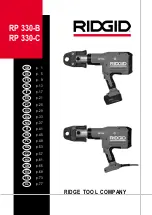
LPK1240K Hydraulic Crimping Tool
Greenlee / A Textron Company
4455 Boeing Dr. • Rockford, IL 61109-2988 USA • 815-397-7070
7
Assembly
Refer to the illustration and parts list for the correct
orientation and placement of parts.
Replace any O-rings, V-rings, seals, and gaskets on
parts that have been disassembled. Apply hydraulic
fluid or O-ring lubricant to all O-rings and all metal
surfaces which they must slide over. When installing
an O-ring which must slide over sharp surfaces, use a
rolling motion and be careful not to damage the O-ring.
Wherever the assembly results in metal-to-metal
contact, coat the surfaces with hydraulic fluid or
O-ring lubricant.
Some steps of the assembly procedure require a remov-
able type of thread sealing and locking compound, such
as Loctite
®
242
®
or equivalent. Follow the manufactur-
er’s instructions for curing.
Cylinder and Ram
1. Install O-ring (10), backup ring (9), and wiper (4)
onto the ram (2).
2. Slide the ram assembly into the cylinder (6) until it
bottoms out.
3. Screw the C-head assembly (1) onto the cylinder (6)
until the flat surface of the C-head is flush with the
similar flat surface of the ram.
Screw the C-head to
the cylinder until these
surfaces are flush.
4. Apply a thread locking compound to the rotational
stop screw (5) and install it into the cylinder (6).
5. Install ring (17), seal (18), and O-ring (24) with
backup rings (25) onto the piston (7).
6. Apply a thread locking compound to the screws
(13). Install shuttle spools (11), washers (12), and
screws (13). Remove excess compound after
assembly and apply a thin coat of oil to the sur-
rounding area.
7. Apply a thread locking compound to the threaded
holes of the ram — one bead of compound along
the entire length of the thread. Install the piston (7)
into the cylinder (6) and secure it to the ram assem-
bly (2) using screws (51) with washers (61). Torque
to 16.9 newton-meters (150 inch-pounds).
Handle with Cylinder Cover
1. Install the ball (62), ball stop (63), and retaining ring
(64).
2. Install two 1/8" pipe plugs (45) into the handle (26).
3. Install the O-ring (24) onto the tube assembly (22).
Slide the tube assembly into the handle (26) and
secure it with the retaining ring (28).
4. Install the spool OD O-ring (38) into the handle,
and install the spool groove O-ring (35) onto the
spool (41). From the trigger side, install the spool
assembly (41) into the handle (26).
5. Opposite the trigger side, install the spring (37) and
spring cap (39), and secure them with a retaining
ring (40).
6. From the trigger side, install the stop washer (36)
and retaining ring (40) into the handle.
7. Install the valve pin (46), spring (47), adjusting
screw (48), copper washer (49) and cap (50) into the
handle.
8. Screw the handle assembly (26) into the cover (20)
until it is snug. Add or remove shims (21) — six
maximum — to allow access to the stop ring adjust-
ment screws (15) and nuts (44). After installing the
proper number of shims, install the O-ring (29).
Reassemble using a thread locking compound on
the threads that mate the handle to the cover.
9. If removed, assemble the screws (15) to the shuttle
stop ring (14) and secure them with the retaining
rings (16). Install that assembly to the cover (20) and
start the seal nuts (44) onto the screws (15).
Note: The setting of the screws (15) isn’t important
now — you will adjust them to the proper position
later in the assembly procedure.
10. Assemble the O-rings (8, 19) to the cover (20).
11. Install the cover (20) into the cylinder (6), aligning
the handle with the C-head. Secure with 12 cap
screws (27). Torque to 32.5 newton-meters
(24 foot-pounds).
12. Position the trigger (32) onto the handle (26), align-
ing the holes. Install the trigger pivot (33) and secure
it with 5/32" external retaining rings (34). Position
the trigger strap (30) onto the handle and secure it
with four screws (31).
Final Settings
1. If the shuttle stop ring (14) was removed, refer to
“Tool Setup” to adjust it to its previous position (for
either open-center or closed-center operation).
2. Set the relief valve to the proper pressure. Refer to
“Relief Valve Check and Adjustment Procedure.”




























